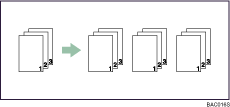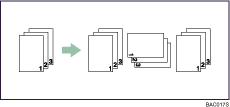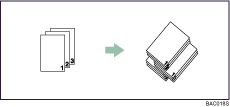


  |  | ||
When printing multiple documents such as handouts for meetings, you can separate sets into order. This function is known as "Collate". Collate stores data transmitted from a computer to the machine's memory or hard disk drive. The followings are the three types of Collate:
![]()
If Auto Continue is set and an error occurs while printing the first set, collate will be canceled.
If form feeding is used and an error occurs while printing the first set, collate will be canceled.
The rotating collate function requires two paper trays containing paper of the same size and type but loaded in different orientations.
If the output tray has shift function, shift collate will be applied even if rotating collate is selected.
When setting collate in the printer driver settings, make sure that collate option is not selected in the application's print settings. If collate option is selected, printing will not be as intended.
Collate Types
Collate
Printed output is assembled as sets in sequential order.

Rotating Collate
Every other print set is rotated by 90 degrees.

Shift Collate
The optional finisher is required for this function.

The finisher shift tray moves backward or forward when a job or set is output, causing the next to shift, so you can separate them.
When Rotate Collate is canceled
If the following functions are selected, Collate or Shift Collate will be applied even if Rotating Collate is selected:
When combined with staple function.
When combined with punch function.
If jobs containing pages of various sizes are set.
When output tray is specified.
When combined with cover sheet and back cover function.
When combined with slip sheet function.
When combined with designated sheet print function.
When combined with tab stock function.
When combined with chaptering function.
When combined with fold function.
When combined with perfect binding function.
When combined with ring binding function.
If custom size paper is set.
Separation Sheet
A separation sheet is inserted between each set.
Separation sheets are fed from the tray specified in the machine's default settings. For details about the separation sheet tray, see "System Settings", Network and System Settings Guide.
![]()
When Rotating Collate has been selected, printing speed will be slower than with other collate functions.
Separation sheets cannot be inserted if "Slip Sheet" is specified.
Set Collate and Rotating Collate in the printer driver.
If you cannot make Shift Collate even with the optional finisher installed, options may not be set up correctly in the printer driver. Correct the printer driver's option settings.
For details, see the printer driver Help.